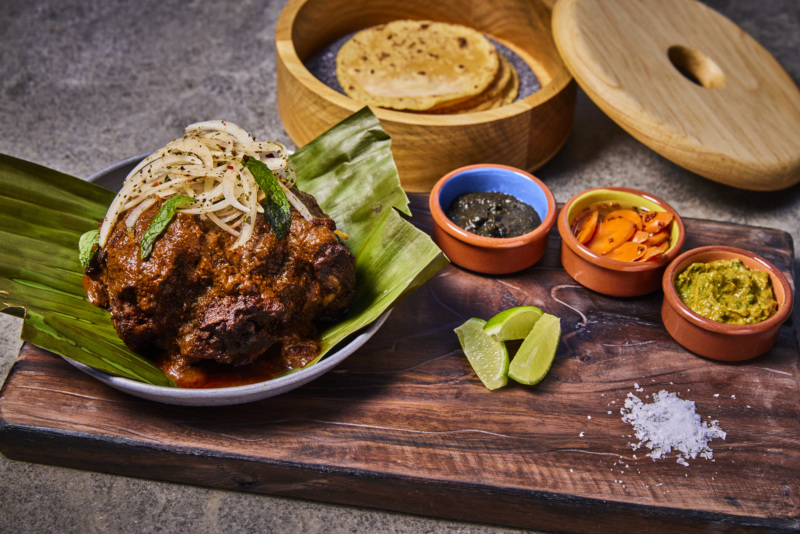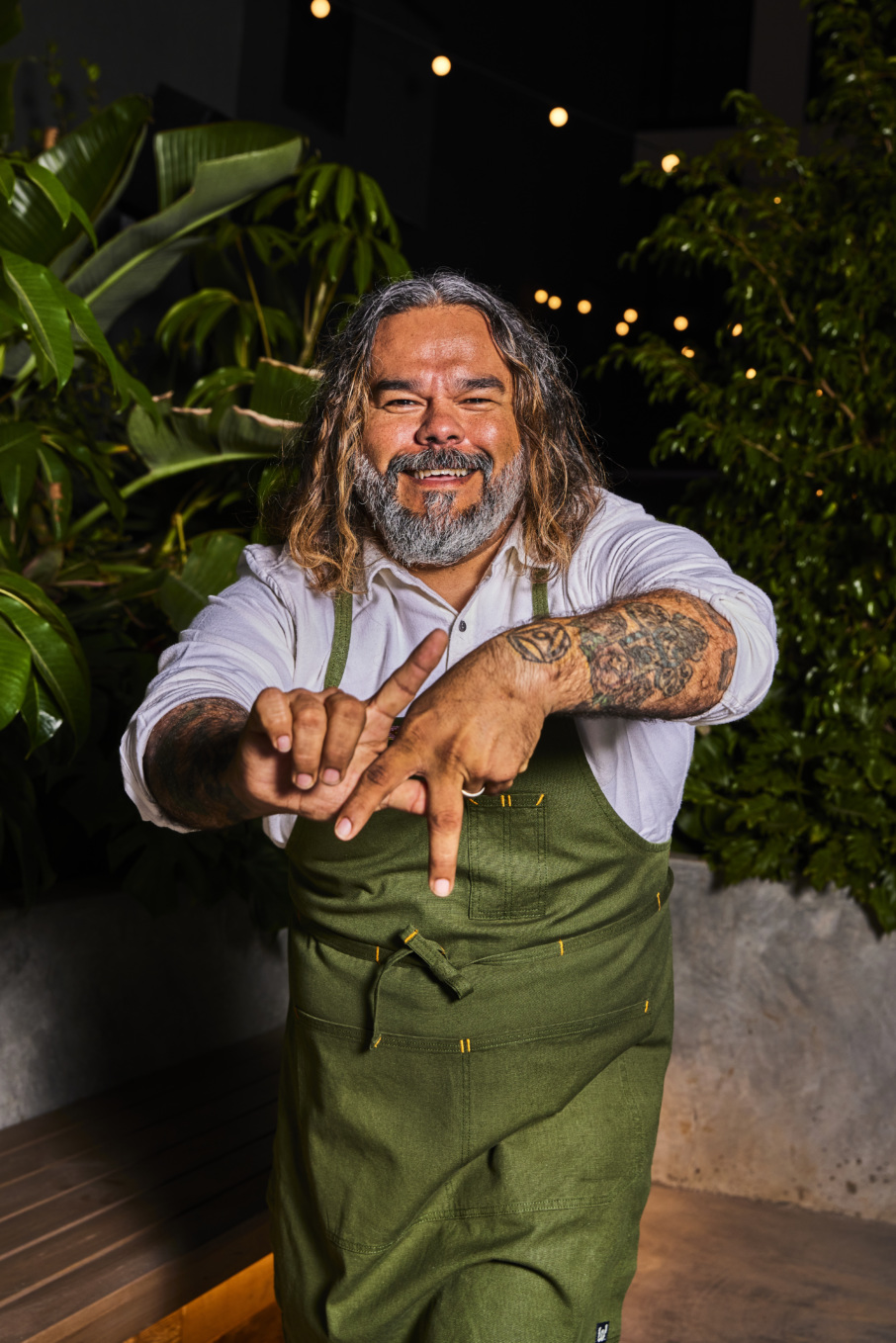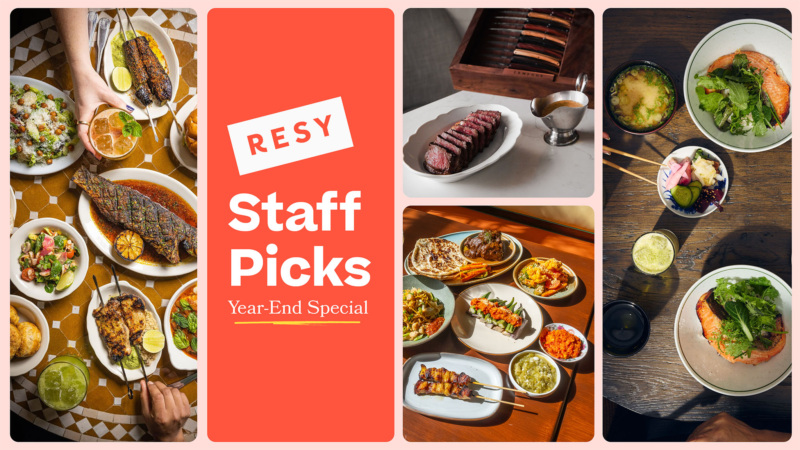
Wes Avila Wants You to See His Mexican Cooking At Ka’teen As Pure L.A.
When Wes Avila left Guerrilla Tacos, the concept he built from street cart to brick-and-mortar space in the Arts District, the public-facing story was that he moved on to take time for family and open a new project at the Ace Hotel in Kyoto. But the reality was something a lot of people were feeling by the summer of 2020.
“I left because I was burnt out. I just couldn’t do it anymore,” says Avila. “I didn’t feel productive, didn’t feel like I was being creative. It was draining me more than it was fulfilling me.”
The feeling didn’t last. Avila indeed opened Piopiko in Japan, but he soon found himself in search of a new project. By the fall of 2021, that manifested in the form of Angry Egret Dinette in Chinatown, a tiny, funky, and mostly takeout spot featuring Avila’s colorful spins on tortas, tacos, and more. And because the chef can’t sit still for long, he also debuted Ka’teen in December, a big, bold, Tulum-inspired restaurant now open at the trendy Tommie Hotel in Hollywood.
If Egret is Avila’s personal culinary playground, Ka’teen is its splashier cousin, opened in partnership with Ten Five Hospitality, the same group behind Evan Funke’s new Mother Wolf and Lincoln Carson’s Mes Amis – all located in the same Thompson and Tommie Hotel complex.
Both restaurants feature Avila’s takes on traditional Mexican dishes, as seen through the eyes of a native Angeleno. That could mean papas bravas served with umeboshi aioli, short rib tacos with shiso, and tuna aguachile with pickled seasonal fruit. None of it, the chef admits, is particularly true to any one regional cuisine. But the menus are pure Avila, a chef who’s earned praise from everyone from the late Jonathan Gold to the James Beard Foundation for his inspired takes on tacos and tostadas.
He continues to push himself in the kitchen, discovering new ways to marry his technically acute fine-dining background with the flavors of classic street food. Avila talked to Resy about moving on from Guerrilla, finding inspiration and discovering new flavors and dishes for Ka’teen, and what Alta California cuisine means to him.
This interview has been edited for clarity and length.


Give us the elevator pitch for Ka’teen. What’s it like?
It’s a tropical oasis in the middle of Hollywood. It feels like you’re escaping to Tulum. Flavor-wise, it’s Mexican coastal cuisine with an L.A. twist. I didn’t go to Mexico and research this one dish and do it exactly the way they do it. I drew from my memories and travels to try to create a dining experience that showcases Mexican cuisine through the eyes of a native Angeleno who went to Mexico quite often growing up.
Are there certain places or experiences that you’re calling upon?
As a kid I traveled to Rosarito, Ensenada, and Baja. I was born and raised in Pico Rivera. Going to Mexico is like going to Santa Barbara for us. My dad had a friend who had land down there and a little beachfront trailer, so he would just rent the trailer for the weekend. My brother and sister would go eat tacos with my mom, but I was a little more adventurous, so my dad and I would hike down the beach, into the tide pools, and basically hit whatever mariscos interested us. A lot of my cooking is from those memories, and from spending time in Tulum. I started going there four or five years ago. Whatever you imagine Tulum to be, it’s exactly that. It’s very much, how the kids say now, a vibe.
A big part of the narrative when you started Guerrilla Tacos was that you left fine dining to open a taco cart, that you applied that technique to the humble street taco. And now you have Angry Egret Dinette, but that’s really different from Ka’teen. What lessons have you brought with you from those scrappier days?
One thing is being adaptable, something I learned cooking on the streets. At Egret, I get to experiment. Some things are in development for Ka’teen or for [Piopiko]. At Egret, it’s all the demos, and I take the final album to the team at Ka’teen. I can do that at Egret because it’s just me, no partners, no investors. It’s a testing ground.


What are some of the hits that have made it from Angry Egret to Ka’teen?
The pescado Zarandeado, which is harder to find in L.A., at least in Hollywood. That’s my favorite. We do a whole fish over binchotan charcoal to order. I like our ceviches a lot, and we’re adding some new raw fish elements, more seafood, and a few extra sides. And the lamb neck, especially in this colder weather. It’s a whole lamb neck that’s braised barbacoa-style, and it comes with a little onion and pistachio on top. It’s got those flavors, that oomph. You make your own tacos with it. This is something you’d serve at a family’s house, it’s a humble dish. We just put it in really nice dishes and present it well.
Angry Egret Dinette definitely has its own personality. You’ve added dinner recently. Do you plan on letting that space and concept evolve and expand more?
We do dinner Friday and Saturday nights. We did taco Thursdays through the summer, and we’ll be starting those again. We do stuff we wouldn’t normally do. Like, we have a pupu platter that comes out with a little hibachi grill, and maybe we do some skewers. Or some mezze like a crab spring roll. Tacos. Maybe a small salad. Queso fundido. Wild mushroom quesadilla. Whatever the f**k we want. We try not to repeat anything, so you can’t get any of these as appetizers unless you get the platter. And we’re two weeks from getting our beer and wine license.
Alta California cuisine has exploded over the last 10 years in L.A. What does that mean to you as a chef and as an Angeleno?
The first three people to do that kind of food were Ray Garcia, Carlos Salgado, and myself. And at the time we didn’t even know each other! But we were all getting started around the same time, and it really developed into this thing. To be classically trained from different parts of California, and all filtering our experiences through food that’s in our soul. It’s in our blood, you know?
Do you worry about the word “authentic” when you’re building these restaurants?
Never. Not any more. I used to get a lot of s**t about that when I was at the taco cart. Not even on the truck or the brick and mortar, but at the cart. People would ask why we don’t have $1 tacos or chicken burritos, and I’d say they could go somewhere else for that. I was a young cook, more vocal then. I had a lot of attitude. I felt like I had to be defensive. I’d tell them it’s not the cart they’re used to. When someone comes at you, and you’re trying to do something different, it’s like, authentic to who, you know? We’re in L.A., not Veracruz or Guadalajara. I’m down with respecting tradition. But I’m authentic to myself, to my customers, my farmers, my vendors.


Guerrilla Tacos was your baby. Was it difficult to walk away?
I left because I was burnt out. I just couldn’t do it anymore. I didn’t feel productive, didn’t feel like I was being creative. It was draining me more than it was fulfilling me, which I never wanted to feel. I didn’t leave in order to work with the Ace in Japan; that was already in motion. I left Guerrilla the summer of 2020, during the pandemic. I was basically in meetings for my Japan project, hiking, drinking, repeat. I told my wife if a little space opened up with a window and a patio, I’d do it. I didn’t look, but I swear the next day, a friend called and asked if I was interested in this Chinatown space.
Do you find the same excitement in creating dishes today as when you first started out, serving things like the uni tostada and sweet potato taco from the truck?
I do. The cooks that I’m working with now are legit. My chef de cuisine at Ka’teen was sous chef at Taco Maria, another was executive chef at Puesto [in San Diego]. They have really solid pedigrees, and they’re excited to work with me and vice versa. I’m not a chef who deals in absolutes. I try not to have the ego. That’s what almost killed me before, the chef holding myself on a pedestal. I’ve humbled a lot and done a lot of therapy.
How did the pandemic make you rethink priorities in the kitchen or with your business overall?
This is not normal work right now. We need to wear masks and social distance, all the things people are sick of hearing about. And we need to have an outdoor space. Both new projects have big outdoor spaces. If either was only indoor right now, I’d be hesitant to work on it because we don’t know how long we’re gonna be in this..
The world needs both kinds of restaurants right now, right? Big, celebratory and communal, and the small indie spots with a bold point of view.
Ka’teen is meant to be shared with friends and family, for sure. There are big tables, lots of room outdoors. That’s what people want right now. Even at Egret, it’s more communal. I think with these larger places, you get to see what a chef is doing, you get to see your friends, you get to be served. It’s like the true meaning of hospitality, especially when it’s really well done. With the indie spots, you’re really supporting small businesses. It’s more like a community space. People who wouldn’t normally come to Chinatown come by. The people who come here are making the effort to support you.
Lesley Balla writes about restaurants, travel, wine, and more. You’ll find her work in publications including Los Angeles magazine, Angeleno, The Hollywood Reporter, and The Seattle Times. In a previous life she was the L.A. editor for Zagat and Eater. Follow her on Twitter and Instagram. Follow Resy, too.
Discover More

Stephen Satterfield's Corner Table















